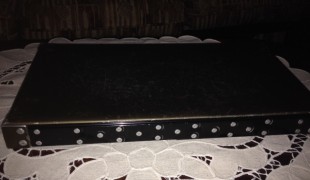- 19814
- 896
- 30
- 22
- 0
- Help Ukraine
About the solution
Just a couple of years after finishing four years of photography school, the accident happened (december 1995). Leaving me with a very high spinal cord injury. I can only move my head, and a bit of my shoulders. Is it still possible to be a photographer? That was one of many questions. First reaction was "of course not", because I could not hold and control the camera with my hands. But that is just the tip of the iceberg, as photography is about way more than having a camera and pusing its buttons. Most of the things that come with photography have become impossible for me, as my options, time and energy are very limited & unpredictable.
But instead of looking at what is not possible, it is better to look at what is possible!
First anolog years
About two years after the In the accident (1998), I had learning how to work with photoshop, with just headmovents. And made some nice portraits with the help of Peep Papa. But directing someone with analog technology proved to be very frustrating, which made me quit it.
First digital years
In the beginning of 2006 new options arose because of the shift to digital photography. My first digital camera was the Sony DSC-R1, the only practical photo camera for me at that time: good image quality, a life view LCD monitor that could face towards my point of view, and the option to connect a remote control. I could then imagine a wheelchair camera set up that would work for me. Kees Meinardi has build the first version.
How does it work?
By moving my right shoulder, my arm slides against a force amplifying lever, that presses on the button of a remote control. By driving my chin controlled wheelchair around, I can point the camera. This construction gave me just enough control to take pictures again.
Check out the photos I made this way:
http://www.laesieworks.com/fotografie/index.html
These are some of the things I need in a camera:
+ A remote controle that I can push by sliding my arm, with my shoulder.
+ A display that can turn towards my eyes.
+ RAW files (extra important because I can not expose that precise)
+ Continues life view, which is present in mirrorless cameras.
My second/latest version wheelchair camera set up, is a big improvement, as the camera can now move: up, down, left, right. It is build by Rob Liefting in 2015. The second camera that worked for me, was the Lumix GH2 (2010), which can also shoot high quality movies!
The next version wheelchair camera I am thinking of, should have a camera stabilizer, as are being used under large mulicopters. And I search for a practical solution to get control over: focus, exposure, and zoom. Some cameras can be remote controlled by a smartphone. But I don't have control over a smartphone... Not yet.
This solution shall not include mention to the use of drugs, chemicals or biologicals (including food); invasive devices; offensive, commercial or inherently dangerous content. This solution was not medically validated. Proceed with caution! If you have any doubts, please consult with a health professional.
-
-
352
-
0
-
4651

Step articulated and mobile
MOVING IN A WHEELCHAIR: Moving using a wheelchair.
Traveling
Urban exploration
Paralysis
Assistive Daily Life Device (to help ADL)
Walking Aid (wheelchair/walker/crutches)
Restoring mobility
Promoting self-management
Managing Neurological Disorders
Building Supportive Community Relationships
Promoting inclusivity and social integration
Recovering from Traumatic Injuries
Maintaining Balance and Mobility
To improve Treatment/Therapy
Raise awareness
Caregiving Support
Neurology
Orthopedics
Rheumatology
Portugal
-
-
-
247
-
0
-
2733

Collaborator James Leckey makes equipment to improve the quality of life and social inclusion of children with special needs
MOVING IN A WHEELCHAIR: Moving using a wheelchair.
BODY BALANCE: Maintaining body balance
STANDING UP: Standing up from a seated position
Playing
Neuromuscular Disorders
Assistive Daily Life Device (to help ADL)
Walking Aid (wheelchair/walker/crutches)
Assistive Technology access
5 Senses support devices: (glasses, hearing aids, headphones...)
Restoring mobility
Promoting self-management
Managing Neurological Disorders
Promoting inclusivity and social integration
Maintaining Balance and Mobility
Raise awareness
General and Family Medicine
Neurology
Orthopedics
Pediatrics
Physical Medicine and Rehabilitation
United States
-
-
-
308
-
0
-
3567

Disabled student designs accessibility map
MOVING IN A WHEELCHAIR: Moving using a wheelchair.
Spinal Cord and Nerve Root Disorders
Paralysis
Cervical spinal cord injury/Tetraplegia
Walking Aid (wheelchair/walker/crutches)
Assistive Technology access
Difficulty coordinating movements
Stiffness or rigidity (difficulty moving)
Paralysis of the legs and lower body
Managing Neurological Disorders
Promoting inclusivity and social integration
General and Family Medicine
Neurology
Canada
-
 en
en